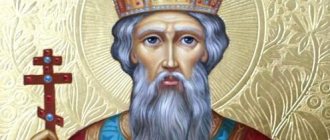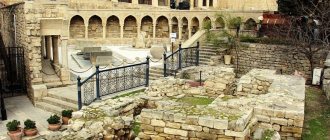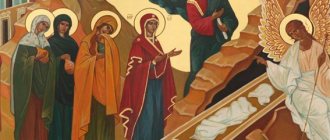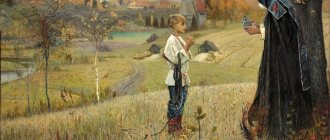Who was Saint Sava?
Sava was the youngest son of Stefan Nemanja and Anna Nemanjic, the crowned family of the Principality of Serbia, the founders of the Nemanjic dynasty. He was born in 1169 and his name was Rastko. And the biblical style is just appropriate here, but more on that below...
Modern Montenegro can be called the birthplace of Saint Sava. He became the third and most long-awaited child in the family, and therefore the most beloved. Little is known about Rastko's early years, but when he turned 15, his father gave him control of one of the regions of his principality. It is known that Rastko did not visit her often. He was an educated young man, familiar with early Christian, Byzantine and Old Slavonic literature. The time came, and he fled to Athos. At that time he was about 17 years old.
On the Holy Mountain, he found refuge in the Russian Monastery of St. Panteleimon, where he became a monk, receiving the name Savva (according to another version, it was the Greek monastery of Vatopedi, in which he lived for the next seven years, but this is less likely).
Surprisingly, after some time his father, having ceded the throne to his middle son, also Stephen, took monastic vows, and even later he responded to Savva’s offer to come to Athos, where his son became his spiritual mentor. The resignation of a worldly ruler to become a monk is an extraordinary event; it aroused unprecedented interest not only in Stefan Nemana, who became Simeon, but also in Savva himself.
Saint Sava of Serbia - prince and educator
“Saint Sava of Serbia - Prince and Enlightener” (part 1)
Author: Simeunovich Mira, Russian language teacher at the school “Knez Sima Markovic”, Belgrade, Serbia Purpose: the material is assigned to colleagues - teachers of history and religious studies, to everyone who is interested in tradition and Orthodox connections of Slavic peoples Description: dear colleagues, on the eve of the great holiday “School Day” in Serbia, I invite you to get acquainted with the life and work of one of the most respected and beloved Serbian saints - St. Sava, who is considered the protector of schools. In the second part I will introduce my students to the meaning of St. Sava for Russians, i.e. why Russians venerate the Serbian saint Goal: presentation of Saint Sava - the greatest personality of Serbian Orthodoxy Objectives: to introduce colleagues to the life of the great saint of Serbia; present the contribution of Saint Sava to the development of the Serbian people and state; expand concepts about the cultural and spiritual heritage of Orthodoxy Preparation: research on Internet resources, study of available Serbian and Russian sources related to the topic Note:
years are given differently in different sources. Therefore, I ask you to take the tentative dates given in the work.
Saint Sava was born in 1169 (1175) in the family of the Župan of Serbia Stefan Nemanja and Anna (daughter of the Greek Emperor Roman). His worldly name was Rastko. His father wisely strengthened the Serbian state. While establishing political and military power, Stephen also spread the Orthodox faith, destroyed paganism, erecting Christian churches and monasteries. His wife Anna was also a virtuous, zealous Christian. Before Rastko was born, they had two sons: Vukan and Stefan. They raised their sons in a Christian spirit. But, from childhood, Rastko prepared for the spiritual path: he visited churches, prayed, and lived his own isolated life. At the royal court, Rastko heard about Holy Mount Athos, since monks often came to the zhupan for alms and talked about the ascetic life.
When Rastko was seventeen years old, a Russian monk came to them from the Holy Mountain, who delighted the young man with words about a soul-saving life, free from worldly worries, devoted to prayer and deeds. Rastko followed him to the Russian monastery of Panteleimon on Mount Athos. The father immediately sent the governor with his squad to find his son and return him home. But Rastko took monastic vows at night while the soldiers were sleeping, and in the morning all they had to do was take his secular clothes, shorn hair and a letter to Savva’s parents (in 1186). The chronicles of the monastery show that the brethren fell in love with Rastko very much, and that very quickly the news spread throughout the Mountain that the son of the Serbian autocrat had settled on Mount Athos. From Panteleimon he then moved to the Vatopedi (Greek) monastery, where he took monastic vows with the name of Sava. Savva lived in the monastery for three years, walked around it barefoot, distributing alms from the rich offerings that his father sent him from Serbia.
Realizing that other Serbs could also strive, following his experience, Savva invited his father to his monastery for a joint monastic life. Župan Stefan had already announced that he wanted to renounce the world and the kingdom. He handed over the rule of Serbia to his son Stephen, and he himself entered the Studenica monastery and took monastic vows with the name Simeon. His wife took on a monastic image with the name Anastasia. Two years later, Simeon arrived to visit his son in Vatopedi. After ten years of separation, they fell into each other's arms. A long time ago they parted as the great zhupan and prince Rastko, and now they meet in a foreign country as monk Simeon and monk Savva. Simeon is eighty-four years old, Savva is twenty-seven. Simeon and Savva together received the blessing to build a monastery for Serbian monks on Mount Athos, found the abandoned monastery of Hilandaria and founded a new Serbian monastery, into which Savva, Simeon and the first Serbian monks moved in 1198.
But in order to (legally) secure the Serbian right to Hilandar, it was necessary to obtain the approval of the Byzantine Emperor Alexei. Therefore, Savva went to Constantinople, and received for Hilandar the status of a self-governing monastery “may Srbima bow to eternity.” The monastery flourished; the “white Hilandar in the middle of the Holy Mountain” was considered an unprecedented miracle. But the Monk Simeon lived in Hilandar for only eight months. Before his death, he asked his son not to leave the Serbian Church, which needed care. After the death of his father, Savva ruled the monastery, supplying books, vessels, icons... He developed monastic rules, drew up a Charter that established the order of worship, the order of life and management of the monastery. He also wrote the life of his father, whom the Council of Athonite Monks canonized as Symeon the Myrrh-Streamer, since miraculous myrrh flowed from his relics and from his wall image, with healing power.
Hearing news of the enmity between his brothers Stefan and Vukan, which threatened Orthodoxy in Serbia (under the influence of the Pope), Sava decided to return to his homeland. He lifts his father's body from the shrine and transports it to the Studenica Monastery, built by Stefan Nemanja himself. At the request of brother Stefan not to return to Athos for now, Savva remained archimandrite in Studenica, which was now called the Lavra of St. Simeon. There's a whole year left. At the same time, he, together with his brother Stefan, began construction of the famous Zic Monastery, which later became the residence of the Serbian Archbishop. Savva did not abandon the Athonite way of life in Serbia. Here he wrote a new typicon, improving the charter of the monastery, establishing the rules and order that he introduced in Hilandar. He even intensifies his labors and demands the reconciliation of the brothers, who, thanks to such a reconciling angel, cease their hostility.
For Sava, the desire for peace is one of the Christian virtues. He even prevented wars by the power of his rational arguments and his eloquence. The people loved him very much and marveled at his wisdom, purity and nobility of heart. In Savva, the people felt their true, true friend and shepherd. People obeyed him and followed him unconditionally, because they saw: Savva lives as he preaches. He was loved for his humility and sincerity. He came to ordinary people as one of his own, but at the same time possessed truly apostolic authority. Sava felt that his works would not be sufficient until the Serbian Church gained independence and independence. Rome was expanding its influence on the Balkan Peninsula, Sava’s brother, Stefan, intended to marry the daughter of the Venetian Doge. This meant opening the way to Latin interests, from which the Serbian people suffered a lot. Because of his brother’s decision to marry, Savva left for Athos, understanding the consequences of such an act. Fortunately, Stefan abandoned his intention. But Sava asked the patriarch in Nicaea to establish an independent Archbishopric in Serbia. The installation of Saint Sava as the first Archbishop of Serbia by Patriarch Manuel I took place in 1219.
Sava at that time was not yet satisfied with the position of the Serbian Church, because it had to submit to the supreme head - the Patriarch of Constantinople, and ensured that the Serbian Church received in the future the right to elect its Primate at the Council of local bishops. With this, a new era began in the history of the Serbian Church, and the previous instability ended. The Serbian Church joined the ranks of other autocephalous Churches. His mission was successfully completed. Returning to his homeland, Sava stopped in Solun to study civil and ecclesiastical laws for the management of the independent Serbian Church. Here he began translating a large number of books from Greek. This is how the Kormchaya Book appeared in the Slavic language, which was later (with modifications) used by the Bulgarians and Russians.
Upon returning to his homeland, Archbishop Sava, establishing holy Orthodoxy and putting church affairs in order, established nine new dioceses in Serbia, and previously only two were known. Now services were performed in the Slavic language, monasteries became centers of spiritual enlightenment, and the Athonite Rule was the basis of monasticism. Saint Sava strengthened the national and religious spirit of the Serbian people with the crowning of his brother Stephen, whose coronation strengthened the Nemanjić dynasty and showed the enormous role of the Serbian Orthodox Church. King Stephen began to be called the First Crowned. Before the death of King Stephen, Sava tonsured him as a monk, and after his death his son Radoslav became king. The day of the enthronement of the first Serbian archbishop and the coronation of the first Serbian king in Žić were very important for the Serbs. These events meant the complete independence of the Serbian people and the Church from foreign states. And both happened thanks to the zeal of Saint Sava. Sava ruled the Serbian Church for 14 years (1219 - 1233), then transferred his power to Arseniy. Established the procedure for electing a new Archbishop, which was adopted by the Council of Bishops in Žić. Having completed his feat in his homeland, Savva went on a pilgrimage to holy places, despite his sixty years. In Bethlehem, Savva entered the stone cave where Jesus was born from the Blessed Virgin Mary. In Nazareth he visited Joseph's house. The saint was in Cana, went to Lake Galilee, and traveled along the Jordan River. He visited holy places in Palestine, Syria, Egypt, talked with ascetics, and ended his journey in Bulgaria, in Tarnovo, where he served the last Divine Liturgy and joyfully went to the Lord in 1237. The Bulgarian Patriarch Joachim (by order of the Bulgarian Tsar) solemnly buried the saint in the Church of the Forty Martyrs in Tarnovo. The Serbian king Vladislav then transported the saint’s body to Serbia (when he was canonized), despite the fact that in Bulgaria neither the authorities nor the people wanted to let him go. Miracles were performed even at the place where the saint’s tomb stood in Tarnovo.
The relics of Saint Sava were solemnly transferred to the Milesheva monastery. In 1594, the Turks transferred the relics of St. Sava to Belgrade and burned them on Mount Vracar, in the same place where the majestic Cathedral of St. Sava stands today. They burned them to destroy the very memory of the great saint. But when the fire caught fire, (according to legend) a pillar stretched upward from the flame, shining with all the colors of the rainbow. Sinan Pasha burned the body of Saint Sava, but increased his glory. The Turks were wrong. The memory of the first Serbian Archbishop remained in his glorious deeds, in folk songs and folk customs. And today, every Orthodox Serb knows by heart the hymn to St. Sava.
From the point of view of science (politics, education, legislation, language), we can conclude that Saint Sava represents a significant historical figure. Some consider it the most important for the Serbian people. He is the spiritual founder of the Serbian people, the founder, organizer, and first Archbishop of the Serbian Orthodox Church. It was he who strengthened Orthodoxy among the Serbian people. The influence of Saint Sava in determining the historical destiny of his people is immeasurable, thanks to his efforts to eradicate the heretical and influences of the Catholic Church. He is the first in the history of the Serbian people to combine the education and upbringing of the people with the Orthodox faith. By defining the Serbian folk faith, he also defined the folk culture, bringing about the spiritual salvation of the people.
Savva is also the first Serbian writer who wrote the most important thing that Serbian society and the state needed at that time. And he remained the greatest prayer book of the Serbian people. As a translator, biographer, and writer, Savva strengthened the Serbian literary language, opened schools at monasteries, and expanded writing throughout the Serbian lands. He traveled around the country, preaching and reconciling the people. He founded the first hospitals at monasteries and brought medicines from the East. The writing of the Helmsman's Book makes Savva the first Serbian legislator who established not only church rules, but also laid down the foundations of civil law. With his Rules of Law, which are based on Byzantine rules about the “symphony” of power and people, Savva speaks of unity, agreement of one with the other, instead of competition.
The educational role is the most important for modern Serbian society, therefore the school “glory” - St. Sava is celebrated in all schools on January 27 (as “School Day”). Then Saint Sava is celebrated as the protector and patron of education, schools, and children. In the Serbian language there is such a concept - “svetosavle”, which denotes the spirit of St. Sava, who lives and is brought up by Serbian schoolchildren (“svetosavle” in Russian). Saint Sava remained a model of spiritual value, a symbol of strength of spirit, dignity and honor.
Thank you for your attention!
Presentation on the topic: Saint Sava of Serbia - prince and educator
We recommend watching:
Summary of a lesson on literature in grade 5 based on fairy tales by A.S. Pushkin Game design (writing an ode in a literature lesson)
Summary of a literature lesson in 5th grade on the topic: Andersen's Fairy Tales Activation of students' mental activity in literature lessons using TRKM
Similar articles:
Lesson summary of Tatar literature in 7th grade for Russian-speaking students
Literature lesson notes in 10th grade
The role of teaching materials in preparing for the Unified State Exam in literature
Summary of a literature lesson in 7th grade on the topic “Features of the structure of a sonnet. History of the development of the genre"
Methodological development of a literature lesson for grade 5 with a regional component on the topic “Journey to the ancient world of the Khanty and Mansi”
Hilandar and SPC
Hilandar is a Serbian monastery that ranks with such Serbian shrines as Vysoki Dečani in Kosovo and Ostrog in Montenegro, but Hilandar is located on Mount Athos, and it was founded by Sava and Simeon. Hilandar became the first and remained the only Serbian Orthodox monastery on the Holy Mountain.
However, then he was simply “Serbian,” and he became “Serbian Orthodox” when Sava achieved autocephaly for the Serbian Orthodox Church from the Byzantine king Theodore I Laskaris and the Patriarch of Constantinople Manuel I Charitopulus Sarantino. At the same time, the monastery remained subordinate to the Patriarchate of Constantinople. But this is not the main thing, the main thing is the new, independent Serbian Orthodox Church.
In 1234, Saint Sava undertook a second pilgrimage to Jerusalem. On my way back I passed through Bulgaria. There he died on January 14, 1236 and was buried in the Bulgarian capital of Tarnovo. Nephew of St. Savva, the Serbian king Vladislav (son-in-law of the Bulgarian king Ivan II Asen), a year later transferred his relics from Tarnov to the Milesheva monastery. Three hundred years after the death of the saint, the Turks, who enslaved the country, burned the relics of Saint Sava in order to humiliate the people and their shrines. Now one of the largest Orthodox churches has been built on this site.
This happened after the fall of Constantinople in 1204, when Manuel I ordained Savva as “archbishop of the Serbian and coastal lands.”
Returning to Serbia, Savva began to found monasteries and laurels and write legislative texts. His Life of Simeon is now considered an example of Serbian medieval literature. Being the abbot of the most important monastery of Studenica in Serbia at that time, Savva also participated in the diplomatic missions of rulers from his family, namely brother Stefan Nemanjic.
Icon of Savva Storozhevsky
The saint came to the Holy Trinity Monastery, founded by St. Sergius of Radonezh, a very young man. His date of birth and family are unknown - there are suggestions that he was the son of a boyar from Smolensk. Having gone through the usual labors and tests, he was tonsured a monk by Saint Sergius himself. Like all the inhabitants of the Sergius monastery, he worked a lot - carried water, built temples and cells, tended the monastery's garden - and also performed ascetic feats of fasting, vigil and prayer . The brothers and the abbot loved Savva for his many virtues, meekness and humility, and always a peaceful state of mind. He fell in love with monastery services and was always the last to leave the church, and for solitary prayer he chose a ravine not far from the monastery. Now there is a spring nearby that bears his name.
Over time, the saint was ordained as a priest and appointed by the abbot of the monastery himself, St. Sergius, to be the confessor of the brethren and also to confess to the laity who came to the monastery to pray. In every monastery this is the most important role and great spiritual responsibility. Saint Sava's advice was filled with God's grace and edification.
Considering Savva ready for an independent life and exploits, the Monk Sergius blessed him to become the abbot of the Assumption Monastery on the Dubinka River, founded by the holy Prince Dmitry Donskoy in gratitude to God for the victory on the Kulikovo Field. In 1392, after the death of St. Sergius of Radonezh and the retirement of the elderly Saint Nikon of Radonezh, successor of St. Sergius, into seclusion (acceptance of the feat of solitary prayer), the brethren of the monastery begged the Monk Savva to become the rector of the Trinity-Sergius Lavra (then bearing the name of a simple monastery). He remained in this post for about six years.
In 1399, Prince of Zvenigorod Yuri Dimitrievich, who was the godson of St. Sergius, asked St. Savva to become his confessor and settle in his domain, founding a monastery there. Leaving the Trinity-Sergius monastery in the care of his disciples, the saint went to the deserted Storozheva Mountain, founding there a temple in honor of the Nativity of the Most Holy Theotokos and a small cell. The prince visited the saint there, asking for blessings on important matters of government - thus, the saint blessed Yuri for victorious campaigns against the Tatars (in Volga Bulgaria, Kazan). Over time, the prayer of the Storozhevsky elder helped preserve Rus' during the invasion of Tamerlane. The Monk Savva predicted victory, and his insightful words came true.
Over time, brethren also appeared in the Storozhevsky Monastery. Despite his old age, Saint Sava worked here too in the construction of churches and dwellings for the brethren. He died peacefully in 1407, at a very old age, having given instructions to the brethren before his death. The Church canonized him as a venerable ascetic of God a hundred years later.
Alas, after the death of the saint, the descendants of Prince Yuri and his brothers began internecine warfare, so the Zvenigorod monastery fell into temporary decline.
Description and architectural style
When developing the project, the authors took the Byzantine style as a basis, focusing on the St. Sophia Cathedral in Constantinople, but adding notes of medieval Serbian style:
- Layout of the Church of St. Sava differs from the prototype in the merging of the basilica and the central building.
- The construction of four smaller towers around the main dome of the Church of St. Sava.
The interior decoration of the Cathedral of St. Sava has not yet been completed, despite the fact that the temple is active and open to parishioners and tourists.
History of the foundation of the temple
The construction of the temple in Belgrade dates back to modern times, but the history of its origin goes back to the distant times of the formation of Christianity in the Balkans.
The landmark was named in honor of the son of the Serbian ruler Stefan Nemanja, who became interested in Christianity and received the name Savva. Having become interested in this religious teaching, the son of the ruler of Serbia made a pilgrimage to Athos and spent many years there, comprehending spiritual enlightenment and training his spirit.
Upon returning to his native place, Saint Sava began to educate the people on the issue of the Christian faith, which helped unite the large number of people inhabiting the Balkan land.
Watching his son’s successes, the father also became imbued with the Christian faith, renounced the throne and decided to live the rest of his days in a monastery. In silence and away from the bustling world, he founded the holy monastery of Hilandar.
Sava continued to attract the people of Serbia to Christianity and became the first bishop on this land, earning love and respect from people who joined the Orthodox religion.
After the death of the bishop, his relics were transferred to the Mileshevo monastery, where they remained until power passed into the hands of the Turkish conquerors under the leadership of the governor Sinan Pasha. In order to break the spirit of the Serbs and outrage their religion and culture, it was decided to burn the relics of the revered Sava in front of the residents of Belgrade. The burning took place on Mount Vracar in 1595. In memory of this event, it was decided to build a temple in honor of Savva, who was canonized.
The first temple was built only in 1835. It was a wooden building, much smaller in size than the modern cathedral.
Considering that the wooden church did not correspond to the importance of the first Bishop Sava for Serbia, it was decided to hold a competition for the design of the new Temple of St. Sava. It took many years, but in 1926 the project of architects Alexander Derok and Bogdan Nestorovich was approved.
Why the cathedral is interesting for tourists
The Temple of Sava is interesting as a cultural heritage of Serbian Orthodoxy, which is its spiritual center and attracts a large number of people who want to touch the shrine.
The scale of the building is impressive, which can be fully felt inside the temple.
Temple of St. Sava in numbers
The dimensions of the Church of St. Sava are as follows:
- width - 81 meters;
- length - 91 meters;
- height at the top point of the dome - 65 meters;
- the height of the main dome excluding walls is 35 meters;
- total area - 7570 sq. meters;
- capacity of visitors - 10,000 people;
- The composition of the temple singers is 800 people.
The numbers are impressive, which speaks of the significance of the temple and the personality of St. Sava in the history of Serbia and all Orthodoxy. In terms of size, the Serbian cathedral is recognized as the second among a large number of Orthodox churches. Second in scale only to the Cathedral of Christ the Savior in Moscow.
Interesting Facts
The construction of the Church of St. Sava took many years:
- Started in 1935 and continued until 1939, raised 12 meters.
- The Second World War suspended construction for a long period.
- The construction of the cathedral continued in 1984 and was completed in 2004, moving on to finishing work.
- Work on the interior decoration is still underway, but this does not interfere with its visitors.
- In April 1999, the temple was visited by His Holiness Patriarch of Moscow and All Rus' Alexy II and conducted the Divine Liturgy with His Holiness Patriarch Paul of Serbia.
The Temple of St. Sava is considered the largest in the entire Balkans and attracts Christians and tourists who want to feel the spirit of a historical place in Serbia.








